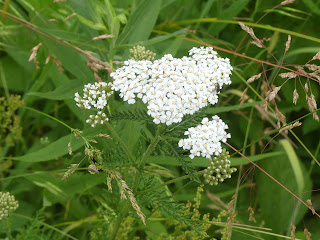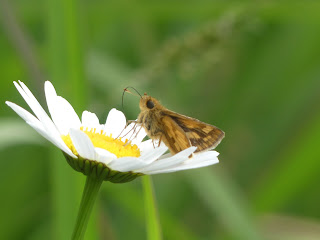Common Yarrow
Here's a Common Yarrow I saw last spring. I'd consider it a mid-sized wildflower, maybe getting 3 feet tall but frequently shorter than that. I personally think they look a lot like a completely unrelated wildflower, Queen Anne's Lace (the "wild carrot"). Both plants are mid-sized, and both have umbels of small white flowers. But there are differences:
- While both have pinnate (fern-like) leaves, Common Yarrow leaves are each more like a single fern while Queen Anne's Lace leaves comprise multiple fern-like leaflets.
- Queen Anne's Lace will usually have a red (or black if it's old enough) spot in the middle of the umbel.
- You'll usually see them at different points in the year, with Common Yarrow being most a springtime wildflower while Queen Anne's Lace is more of a summertime 1.
I mentioned they're unrelated; Queen Anne's Lace is in the parsley/carrot family while Common Yarrow is in the aster/sunflower/daisy/composite family. While the Common Yarrow flowers are smaller than most of the wildflowers in this family, there are other family members with lots of small flowers, like Joe Pye Weed and the goldenrods.
While the Common Yarrow species is native to North America, not all the subspecies and varieties are from around here. My impression is that the non-native subspecies and varieties can hybridize with our native Common Yarrow variety, and unless you routinely perform DNA analysis on the wildflowers you encounter, you may not be able to tell whether the yarrow you're seeing is native, invasive, or some combination of the 2. Similar to Stinging Nettle, I suspect that hybrids can fill basically the same ecological niche as the pure natives, so I'm not sure it's worth worrying about hybridization.
 |
| June 3, 2023 at John Clyde Native Grassland Preserve Photo 300859113, (c) jpviolette, some rights reserved (CC BY-NC) |



Comments
Post a Comment